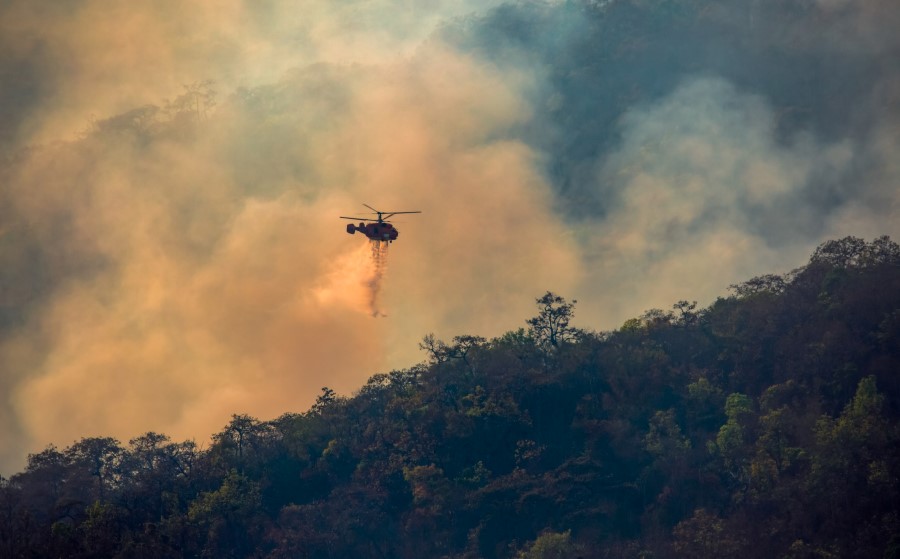
Being as prepared as possible ahead of bushfire season will help small businesses get back on their feet a lot quicker should disaster happen.
Now is the time to consider possible impacts and learn about the plethora of support available, Business Recovery Advisory Service advisers said at a recent two-part series of Ai Group webinars.
“You won't have to navigate recovery alone,” webinar co-host Millie Wall said.
While 60 per cent of small-to-medium-sized enterprises (SMEs) in Victoria were impacted in the 2019-2020 bushfire event, that number jumped to 90 per cent in bushfire-prone regions.
“We also know bushfires are becoming more frequent and severe, which means impacts to businesses may continually increase,” Ms Wall said.
“Therefore, it’s important to plan and prepare as best as you can, so when an emergency does occur, your business is in the best position possible to respond. It’s one less thing for you and your staff to think about.”
Consider who is responsible for this preparation.
“It's important to appoint yourself or a key staff member so you know steps have been taken and people know who to turn to,” Ms Wall said.
“Above all, keep the wellbeing of yourself and your staff and family at the forefront of everything you do.”
Every business has a unique level of risk during a bushfire, so consider factors relevant to your enterprise.
These include:
If your business provides these services, you may need to modify your operations sooner than you would expect.
It’s important to consider possible impacts so you can plan your response.
Technology and telecoms can be impacted through power and system outages.
If your business relies on online systems or EFTPOS, consider back-up options to minimise disruptions.
Closures and stoppages might be enforced by emergency services, forcing you to change the way you operate — moving from bricks and mortar to online sales or from sit-down dining to takeaway.
Other businesses might require staff to work from home.
“The impacts to staff availability and their wellbeing should be key considerations in your planning, along with the flow-on effects of supplier and freight disruptions,” Ms Wall said.
“Also, consider region-wide impacts to tourism during bushfire season such as fewer tourists and widespread cancellation of events and bookings.
“Although these impacts are beyond the control of a small business, it’s wise to consider them and plan for worst-case scenarios.”
Some businesses and industries will see an increase in demand for their services and products in the event of a bushfire.
These include:
“If your business is in that fortunate position, be prepared to manage this influx in demand,” Ms Wall said.
“There may be a long-term change to your market, so you might need to consider branching out into new services or products or changing the way you operate or the locations you service.”
Start preparing your premises and work sites.
Dispose of waste, fireproof buildings by clearing gutters and gardens and store flammables far away.
Implement a policy to keep vehicles well maintained and fuelled and have site and store shutdown procedures for high fire-danger days so you're prepared if you can't go back to the business or site.
Next, focus on issues such as cashflow, customer loss and supply chain disruption.
“Cashflow is never more important than during a crisis,” fellow webinar host, Michael Duncan, said.
“If your business is forced to close for four weeks during the bushfire season, have you got the cashflow to pay your rent, staff, suppliers, overheads and tax obligations?”
Generate cash reserves of two to six months of operating expenses, Mr Duncan advises.
In addition, reduce any overheads and supply costs and review your fuel and energy costs. Review payment terms with your suppliers, customers and clients and ensure you're being paid within 40 days. Review efficiencies across the entire business to determine what's costing you money and where you can save.
“Look at your liquidity to cover business debts,” Mr Duncan said.
“What are your liabilities? How are you operating financially at the moment, and can you cover your liabilities for up to six months?”
Also, have a clear understanding of your leave liability position.
If multiple staff resign and need to be paid out on their annual leave while your business is not generating income, how would you manage to pay out that leave?
“Having good relationships with banks, suppliers and customers is so important,” Mr Duncan said.
“Keep a digital record, or create a spreadsheet at the very least, with key business relationships so when you're under pressure, you can easily identify who to chat to.
“Some suppliers may be incredibly accommodating but those facing their own financial pressure and interruptions may not be as empathetic.
“We've seen many situations where a business is ready to open but they’ve got nothing to sell or produce because their key suppliers are still impacted.”
Now is the time to look at your supplier contracts to consider how cashflow could be impacted by factors such as delivery delays — if key deliveries need to take a different route, potentially adding 300km to the journey, additional costs will be incurred.
Scammers never miss ‘a good crisis’, Mr Duncan said.
“In the event of a bushfire — when you’re stressed, not sleeping and reading emails with one eye open — some of the first messages you'll receive will be from fake accounts offering grant monies and the like,” he said.
“No matter how much you're on your knees, they'll take every opportunity they can to put you down. That’s why it’s important to know who you need to deal with so you're not responding to erroneous emails and text messages.”
Store data on cloud-based software, create back-ups, keep passwords safe and if your records are damaged, speak to your accountant or the Australian Tax Office (ATO).
Obtaining accurate records is key for recovery and being able to operate your business remotely.
Seek advice to ensure your business is adequately insured in the event of a bushfire; a standard insurance policy might not provide enough coverage.
“Being underinsured has been a huge issue during recent bushfires and floods,” Ms Wall said.
“Many businesses have also been caught out because they don’t understand policy exclusions. It's a complex industry, but you don’t need to navigate insurance on your own.”
When it comes to bushfires, it’s critical to have:
Ensure your policies cover the cost of replacement or rebuild and be aware of excesses you might need to pay and limits of liability.
Keeping financial records up to date will avoid delays in processing a claim.
You might have a bushfire plan for your home, but do you have one for your business?
Free templates, such as this one from the CFA, are available and and can be modified to suit your business.
Include key information such as:
Involve your staff in planning, know your evacuation procedure and be prepared to leave at a moment's notice.
“If emergency services have alerted you that it’s time to leave, the safety of you and your staff is paramount,” Ms Wall said.
“Equipment and documents can be replaced.”
Even the smallest amount of preparation and planning could be the difference between navigating the situation and feeling confident about it or feeling overwhelmed and deflated.
“No one has found themselves in a situation that they wish they were less prepared for,” Ms Wall said.
The good news is that small business owners are well-placed to navigate a crisis.
“If anyone has the skills and resilience to navigate the impacts of a bushfire, it’s a small business owner,” Ms Wall said.
“You already have the skills to recognise a problem, create a solution and navigate through it. It’s why you started a business; you saw a problem or gap in the market, and you created a solution.”
The Business Recovery Advisory Service, delivered by Business Victoria in partnership with Ai Group, provides expert guidance and tailored support to small businesses affected by the 2022 Victorian floods.

Wendy Larter is Communications Manager at the Australian Industry Group. She has more than 20 years’ experience as a reporter, features writer, contributor and sub-editor for newspapers and magazines including The Courier-Mail in Brisbane and Metro, the News of the World, The Times and Elle in the UK.